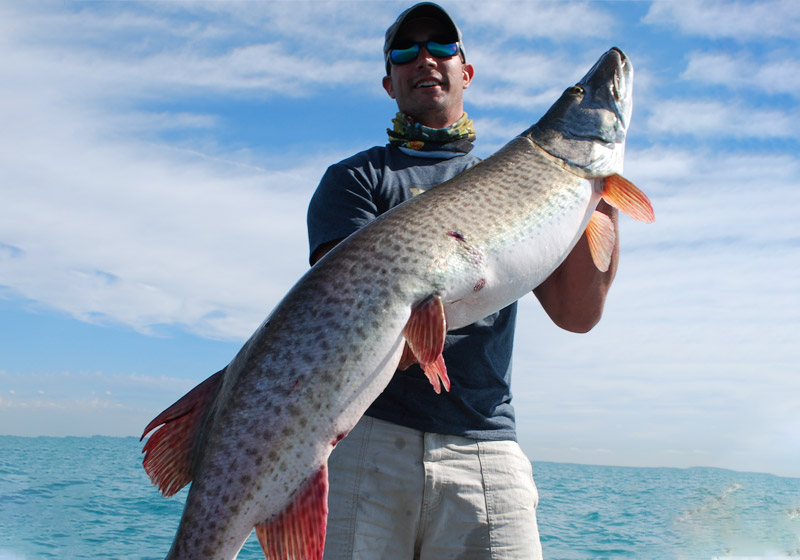St Clair Fall Fishing

One of the most exciting fall musky fisheries in the world right now is Lake St. Clair! This massive body of water is located on the Great Lakes and is sandwiched between Lake Huron and Lake Erie just north of Detroit, Michigan. The 274,000-acre body of water is home to an astronomical number of muskies including some real giants. This unique lake is one of the only bodies of water in the world where you can honestly hope to catch both double-digit numbers of fish and multiple 50 inchers in the same day. The fall on Lake St. Clair however is a bit of a tricky matter with a handful of extremely volatile factors making the difference between the day of a lifetime and the big goose egg.
Despite its massive size, Lake St. Clair averages only 11 feet in depth and the deepest natural part of the lake is only 21 feet. Additionally, the lake is also known for its extreme lack of structure. Without a single rock bar, breakline and very few weed beds plus the extremely shallow water, it truly is set up differently then any other water in the musky range. This lack of structure causes the baitfish and muskies to relate mostly to favorable water temperature and water clarity rather then traditional musky structure. The watercolor on Lake St Clair in the fall is based around the wind and the effect that the wind has on the shallow water. The shallow nature of the lake allows for wind and wave action to stir up the muddy bottom very quickly especially in the fall. When the water temperature drops below 55 degrees the vast majority of the vegetation in the lake begins to die off. The lack of weeds will then allow the sediment that was held down by the weeds in the summer to get stirred up very easily. Additionally, the cold water of the fall is much less dense then the warm water of the summer. Think about swimming in a lake, your head and shoulders are always in warmer water then your feet; this is because the cold water is more dense and therefore sinks. This dense cool water in the fall will not allow the sediment and dirt to settle out nearly as fast as the thinner warmer water does. These two concepts make the fall water clarity on this shallow water lake extremely variable. It is not uncommon for the water clarity in the lake to go from five feet of visibility to two inches in a matter of hours if the wind picks up. Since water on St. Clair is typically very clear during the summer months it seems like the fish are very accustom to feeding using sight rather then strictly lateral line sense. For this reason finding areas of the lake that have cleaner water is imperative to catching fish. The best way to locate clear water on this massive system is to watch the wind for two to three days prior to your trip. If the wind is coming out of the south for 72 hours, then the south shore will be clean and the north will be extremely muddy. When you can find water that has at least two feet of visibility in it you are always going to be in good shape to load the boat with big fall muskies on St. Clair!
When it comes to fall fish locations on St. Clair, the name of the game is inflowing water. All of the major rivers that flow into St. Clair have deeper river channels and most of them have warm water discharges in them as well. The deeper and therefore warmer water flowing into the lake will cause huge numbers of both baitfish, primarily gizzard shad, and muskies to stack up at the mouth of these rivers. All of these river mouth areas on St. Clair, particularly the Thames River, Belle River, Puce River, Clinton River Spillway, Clinton River, North Channel, Middle Channel, South Channel and the Detroit River will be prime areas in the fall as long as the water clarity is correct. When you are fishing these river mouth areas you typically want to look for fish right where the river mouth meets the lake. Most of these areas are between six and ten feet of water in the lake and a bit deeper in the river. Your best areas will be straight out from the mouth of the river in the lake on those six to ten foot flats. While you are fishing these areas always be looking for the presents of gizzard shad schools which will be relating to the warm inflowing water. By locating these big schools of baitfish you will ensure that you contact plenty of big fall St Clair muskies.
The tactics and lure selection for fall St. Clair muskies is actually pretty simple by musky standards. For nearly a century it has been known as a trollers paridice due to the lack of structure and the shallow open nature of the system. If you are looking to troll, 8-10 inch crankbaits that have large floppy wobbles seem to be the most effective. Top producers are 10 inch Enforcers by Donatos Custom Lures, Custom X Fury’s, and Shallow Invaders by Musky Innovations. Due to the extreme lack of structure on Lake St. Clair a mast planner board system is typically the best way to run your trolling spread due to its unmatched ability to allow you to cover water and spread out your lures. During this period the schools of shad normally suspend high in the water column thus forcing the muskies to feed up near the surface of the water. Because of this it is very important to present your trolling lures up in the top half of the water column. By doing this you will ensure that your baits are presented perfectly in the strike zone just above the muskies. When it comes to trolling speeds it seems like 3.5 to 4 mph is the most consistently productive. The relatively fast trolling speed allows you to cover large amounts of water helping you to locate muskies around these river mouth areas as well as dial in the bite. Additionally the higher speeds help to get reaction strikes from the fish adding a much-needed trigger to your presentation. Due to trolling’s unmatched ability to allow an angler to cover water quickly and locate fish I would always recommend this tactic for anglers who are new to St Clair or who have not been out lately enough to have a good starting point. By spending a couple hours trolling one or several of the river mouth areas you can gain a great understanding of where you are looking to fish and where the bait and muskies are most concentrated.
Relative to trolling casting in the fall on Lake St Clair is an extremely new concept however it has produced some huge results. The biggest factor that you need to consider while trying to cast on St Clair in the fall is your very limited ability to cover any ground. Due to the size and relatively featureless areas you are fishing it is doubly important that you use your electronics in order to locate baitfish and make sure that you are located in areas that are holding fish. I relay highly on Humminbird 360 degree imaging to make sure that I always know exactly where the baitfish and muskies are located. Due to the fact that you are typically fishing in less then 12 feet of water on St. Clair in the fall, the shad who suspend high in the water column will not normally let your boat get straight on top of them thus making traditional sonar nearly useless and side imaging or 360 degree imaging a must to find these baitfish and the muskies that follow them. When it comes to fall lure selection, the name of the game is rubber! Magnum and pounder Bulldawgs by Musky Innovations and Regular and Monster Medusas by Chaos tackle are always the top producers. The life like action of these large rubber baits proves simply irresistible for these fish and results in catching monster fish after monster fish year in and year out. The key to these baits is not only the life like action but also the ability of these lures to be fished extremely slowly with a stop and go retrieve in order to entice strikes. Simply pull the rod, causing the lure to go forward and up in the water column, then reeling up the slack, letting the lure sink and then repeating. This will cause the lure to not only stop and start but also to go up and down in the water column triggering strikes from big fall muskies. Additionally when you factor in that 98% of the fishing pressure that these fish experience is from trollers the muskies are very used to watching baits travel in straight lines at constant speeds. Nearly every fish in the lake has been caught on these trolling lures however when you start to use a bait that both stops and starts and goes up and down in the column you are giving the fish something they have not seen before and thus will trigger a lot of strikes! The last thing to consider when working these baits is your speed. In the fall the water goes from cold to very cold the closer you get to ice up. Since muskies are cold blooded that means their metabolisms will decrease as the water chills and thus will make them less likely to be willing to chase down a fast moving casting lure. For that reason, it seems like the later in the fall it gets the slower your pulls and the longer your pauses in between pulls should be. Right before ice up it is often necessary to seemingly crawl your bait along the bottom to get a strike from those late fall super tankers. The slow retrieve speed combined with stop and go action and a large profile makes big rubber a must have for Lake St Clair in the fall.
Whether your trolling or casting Lake St Clair is an extremely exciting place to be musky fishing in the fall. By understanding the key concepts behind what drives this fishery you will be better suited to locating and catching fish in this amazing fall fishery.
HOURS
Monday
7:00am - 8:00pm
Tuesday
7:00am - 8:00pm
Wednesday
7:00am - 8:00pm
Thursday
7:00am - 8:00pm
Friday
7:00am - 8:00pm
Sat. & Sun.
7:00am - 8:00pm
Spencer's Angling Adventures
29474 Old North River Road
Harrison Township, MI 48045
(419) 410-0498


